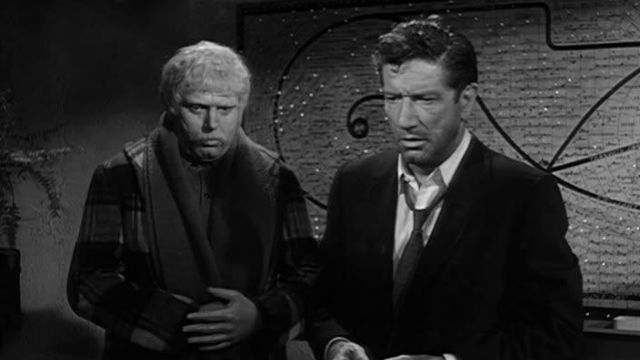Movie Review: I Bury the Living (1958)
“Out of a time-rotted tomb crawls an unspeakable horror!”


I Bury the Living (1958)
Director: Albert Band
Cast: Richard Boone, Theodore Bikel, Peggy Maurer
Synopsis: A cemetery director discovers that his customers die when he changes the status of their plots from vacant to occupied on the cemetery plan in his office. .
Like us on Facebook
Catch all our reviews on Facebook.
Sometimes writers get a great idea for a story but can’t come up with an ending to do it justice. Given the calamitous weakness of its ending, one could be forgiven for assuming that’s the case with Albert Band’s I Bury the Living For 70 gripping minutes it’s arguably one of the finest horror movies of the 1950s; its fantastic scenario is handled with a deft intelligence that surpasses its B-movie origins and propels us into the most personal of horrors in which its beleaguered protagonist wrestles with the demons awakened in his mind by a very real nightmare that only he can see. Unfortunately, I Bury the Living has a running time of 76 minutes, and what happens to the movie in those final few minutes is not unlike the fate of those poor souls whose lives appear to rest upon the position of one black pin. The real tragedy, though, is that Band rejected writer Louis Garfinkle’s much better original ending…
Richard Boone (The Kremlin Letter, The Shootist) plays Robert Kraft, the scion of the small town of Milburn’s wealthiest – and most philanthropic – family, who is saddled with the responsibility of managing the administrative duties of the town’s cemetery. He works from a cottage situated on the perimeter of the cemetery, and on the wall of this cottage sits a map detailing the location of every plot. Those which are occupied are identified by a black pin, while those which patiently await the arrival of their owner are indicated by a white one. It’s a simple enough system, but Robert botches things when he accidentally places black pins on two plots given to a young couple as a rather bizarre wedding present by the groom’s father – a mistake he only realises he’s made when he receives the news that they have both perished in an automobile accident on the very same afternoon that the plots were allocated to them.
Kraft’s rational side would like to write it off as a chilling coincidence, but the primal, superstitious corner of his mind compels him to randomly place another black pin in a plot whose owner is yet to die in order to prove his fears are unfounded. Imagine his horror, then, when that poor soul dies unexpectedly the very same day. It really does seem as if Kraft has the power of life and death over those who have purchased plots in the cemetery, and while many of us would choose to keep this terrible gift to ourselves and exercise extreme caution when inserting black pins into the map in future, Kraft makes the mistake of telling his uncles, all of whom disbelieve his wild claims. Even worse, they insist on being used as guinea pigs to test Kraft’s theory further…
I Bury the Living flies for 70 minutes as it presents us with a clinical and entirely feasible study of one man’s psychological disintegration under fantastic circumstances. Without respite, it relentlessly forces Kraft to not only doubt his own sanity but to question everything he thought he had known about himself. Why him? What man must he be to possess such a terrible power? The depth of Kraft’s torment sets him apart from the protagonists of similar movies of the era, and our sympathy for his plight is aided immeasurably by a performance of immense strength and sensitivity from craggy-faced Richard Boone, an actor who was under-rated while alive and has been largely overlooked since receiving his own black pin. Band directs I Bury the Living as if were a Noir , with slowly enfolding darkness providing a visual indication of Kraft’s crumbling state of mind in the same way that the slowly increasing size of the cemetery map symbolises the way it is becoming the sole, forbidding focal point of his life.
As good as I Bury the Living is, it still qualifies as a failure because of Band’s stunningly bone-headed decision regarding that ending. In Louis Garfinkle’s original screenplay, Kraft is confronted by his ‘victims’ when they rise from their graves after he switches their black pins for white, and one can’t help feeling both sad and frustrated about how much better that ending would have been. Band had no way of knowing it back then, but this was his one chance of achieving a moment of greatness in cinema. And he blew it.
(Reviewed 18th January 2017)
httpv://www.youtube.com/watch?v=tAM7PHnP7Yw

0 Comments